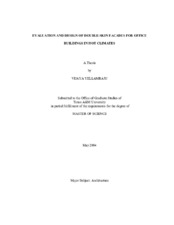| dc.description.abstract | The main objectives of this research are (a) to investigate the thermal effect of double skin facades in office buildings in hot climates and (b) to propose guidelines for their efficient design based on this evaluation. The study involves the energy performance analysis of two buildings in India. A base case with the existing building skin was simulated for both the cities. The main source for the high cooling loads was found to be heat gain through windows and walls. This led to the evolution of a series of facade strategies with the goals of reducing heat gain, providing ventilation and day-lighting. The buildings were then simulated for their energy performance with the proposed double-skin strategies. Each of these strategies was varied according to the layers constituting the facade, the transparency of the facade and the orientation of the facade to which it is applied. Final comparisons of energy consumption were made between the proposed options and the base case to find the most efficient strategy and also the factors that affected this efficiency. The simulations were done using the building simulation software, Ener-Win. The double skin was simulated as per an approximate and simplistic calculation of the u-value, solar heat gain coefficient and transmissivity properties of the layers constituting the facade. The model relied on logically arrived at assumptions about the facade properties that were approximately within 10% range of measured values. Based on inferences drawn from these simulations, a set of design guidelines comprised of goals and parameters was generated for design of double-skin facades in hot climates typical to most of the Indian subcontinent. It was realized that the double-skin defined typically as a 'pair of glass skins separated by an air corridor' may not be an entirely energy efficient design strategy for hot climates. However, when used appropriately in combination with other materials, in the right orientation and with the right transparency, a double-layered facade turns out to be an energy efficient solution. | en |


